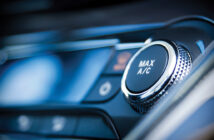As the world went into lockdown at the beginning of summer, travel became an afterthought. People were asked to stay home and many complied as the world fought to limit coronavirus transmission. The quarantine hurt airlines and other industries that rely on tourism and business travel. Flint Bishop International Airport (BIA) was no exception; however, BIA leadership made the decision to adapt around a rule of safety and progress. “When the virus hit, we started looking for ways to improve safety and work within CDC guidelines,” explains Airport Director, Nino Sapone. “Europe was ahead of us in terms of infection detection technology, so we looked there for a solution.” In August, BIA became the first to utilize the Smart Helmet developed in Rome, Italy by tech company, Keybiz.

“WE ARE ALWAYS LOOKING FOR THE NEWEST TECH THAT WILL HELP MAKE THE AIRPORT THE BEST IT CAN BE.”
Nino Sapone, Airport Director
“The other airports at the time were investing a lot of money on a multitude of static cameras in order to detect a possible infection. When we did our research, we found that the Mobile Smart Helmet was a more effective and economical tool,” explains Sapone. “It’s the first of its kind.” Worn by airport police officers, the helmet can detect the body temperature of up to 20 people in seconds with precision accuracy while the officer roams the airport. If the device detects the temperature of a passenger to be 100.4° Fahrenheit or higher, the officer will ask the person a series of CDC-recommended questions and perform a second scan to determine whether the person will be allowed to board a plane. If the passenger is disembarking from an inbound flight, their airline will be notified of the scan for contact tracing. “We hope to help limit the spread of the disease,” says Sapone. If the individual with an elevated temperature is not a passenger, they will be asked to leave the terminal building in the interest of public health and safety.
The Smart Helmet is an additional layer of protection for passengers against viral infection and it has additional capabilities outside of the pandemic. Utilizing facial recognition, it can identify wanted criminals, suspects or missing persons. Photos of these individuals can be uploaded to the helmet when a law enforcement BOLO (Be On the Look Out) is issued. The helmet also has the ability to scan and recognize license plates and QR codes. The helmets come with an accompanying watch that can also scan body temperatures, as well as take photos and video. Future technology being considered includes sunglasses designed with the same functionality as both the helmet and watch.
Computed Tomography (CT) Scanner
In October, as part of a continued effort to improve the passenger experience, the Transportation Security Administration (TSA) installed a new Computed Tomography Scanner at BIA. Through state-of-the-art technology, airport TSA officers are able to review most luggage without opening it or handling its contents. “It limits the amount of handling and searches by officers,” says Sapone. “Laptops and electronic devices can stay right in the bag. The passenger experience will be quicker, safer and more effective.” When the passenger’s bag enters the machine, an x-ray camera takes hundreds of images as the luggage is spun on the conveyor belt. It generates a 3-D image that the TSA officer can rotate on-screen for more thorough analysis. This capability makes it easier to detect shape and density of items including bulk and liquid explosives. Travel-sized liquids will still have to be removed prior to the scan. “We are always looking for the newest tech that will help make the airport the best it can be,” adds Sapone. “Only a handful of airports are currently equipped with this scanner.”
In addition to the new technology, BIA has finished a complete runway resurfacing and upgrade that was planned in 2019 and made possible by a $9.3 million grant from the Federal Aviation Administration (FAA). The upgrade included enhanced LED lighting and electrical systems.
As the quarantine slowly began to lift, the airport began integrating more flights to Chicago, Nashville and Charlotte. The Sarasota and Fort Lauderdale flights have also recently returned in addition to a new non-stop flight to Las Vegas. Plans are moving forward for the airport and negotiations with Delta Airlines are to begin after the first of the New Year. “We are full speed ahead,” says Sapone. “The regional and community support has been great throughout this pandemic. Thank you.”
Flint Bishop International Airport urges all travelers to follow recommended COVID-19 protocols. Masks are required throughout the terminal and six-foot separation is recommended. The airport has ramped up sanitation procedures to keep the public safe. For more information, visit bishopairport.org.

















